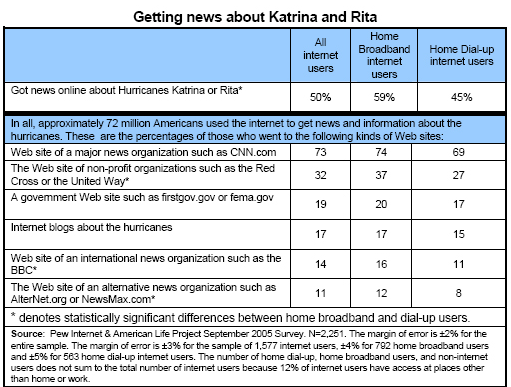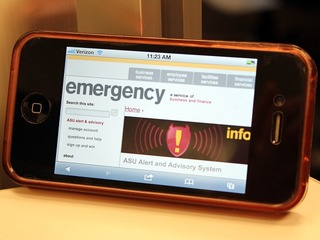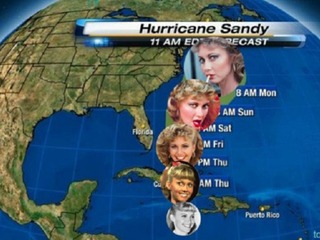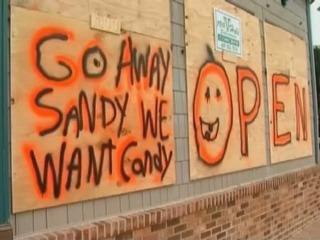

Unless you’ve been under a rock for the past week, you know that large parts of New York and New Jersey are under water from Hurricane Sandy. Watching the news footage, it’s nearly impossible to not get flashbacks to Hurricane Katrina, and the devastation that seemed to go on forever (and, in some ways, still goes on today.)
So now that we’ve had our second gigantic, city-destroying storm in less than a decade, it seems like a good time to take a look at how the invention and adoption of social media has changed the way we get our news, and our updates.
How did people get their updates in 2005?
Some of the differences are obvious. Of course, these days we don’t have to rely just on the talking heads on television, or even experts on the Internet, to tell us what’s going on; we can get our updates directly from our friends and family, who can post updates in real time on social networks.
But it’s not just about how we get our news, it’s about the resources that have been put in place by those networks to help people. As people shift the way that they get their news and updates, many of the biggest online resources have stepped up to the plate to really deliver help to those in need.’
When Hurricane Katrina ravaged New Orleans in August of 2005, killing 1,833 people, and costing $108 billion in damage, there was no Twitter or YouTube. Even Facebook was less than a year old.
Without According to a Pew Internet report from November 2005, only 50% of all Internet users got information about Hurricanes Katrina or Rita online. This was only about 72 million people at the time.
Around 73% of those 72 million people got their news from a major news organization, by far the biggest piece of the pie. Websites for non-profits were the second most visited, with only 32% visiting them.


With few official social networks, it was up to individuals to get the word out about what was going on.
Tara L. Conley of Ms. Magazine recently wrote about what she calls “women virtual volunteers” who created blogs and newsgroups to get information out to people during Hurricane Katrina.
“I witnessed virtual volunteers, some of whom were also survivors of Katrina, posting resource information and organizing clothing and food shipments using blogs, list-servs and Yahoo! groups. I primarily looked at three web platforms, including Real People Relief, Katrina’s Angels in Action Forum and Beyond Katrina, all created and maintained by women to directly support the needs of Katrina survivors across the country,” she wrote.
“These women not only used the platforms to exchange resources and information, but also found refuge in these online spaces. Women supported each other emotionally when it seemed as though their government and families had failed them after the most devastating natural disaster in modern U.S. history.”
Without places for people to congregate, people had to create their own spaces to give comfort to those who needed it. According to the Pew Internet study, around 5% of internet users, or 7 million people, went online to set up their own relief efforts. And 4% posted their own material, including comments, links, and pictures related to the hurricanes on online blogs, bulletin boards or chat rooms.
The study also found that a mere 17% went to Internet blogs to learn about the hurricanes. People either did not know about these resources, or they just did not seem to be all that interested in getting their updates from their fellow users.
Social media in 2012
Things have certainly changed in that regard since then, in both the way that people connect with each other, and the resources available to people online.
Compare these numbers to some of the statistics of how often people were updating content on social media during Hurricane Sandy.
According to analytics firm Topsy, over 3.2 million Tweets with the hashtag #sandy were sent in 24 hours. In just the past week, 11 million Tweets were sent.
On photo-sharing website Instagram, people posted 10 pictures of the hurricane every single second during the height of the storm.
On Facebook, all of the top ten search terms were about Sandy during the height of the storm, and in the aftermath.
While it was going on, some of the top terms included “stay safe / be safe,” “prayers / praying,” and “my friends.”
After the storm, terms like “we are ok,” “hope everyone is ok,” and “made it” took the top spots.
Social media has no doubt become not only a resource to get the latest information from people about what is happening, but it has also become a way for people to send out instant messages to their family and friends to either wish them well, or to tell everyone that they are ok.
The shift to mobile
Perhaps the biggest change since Katrina is the fact that everything is on mobile, which allows people to send and receive update constantly, even when they don’t have power.
I used to joke about news reports regarding blackouts. Obviously, if someone has no power, they couldn’t watch TV, so telling them their power was going to be back on was kind of useless. Now, that is not the case at all. I saw status after status on Facebook telling me that someone’s power had just gone out (whether that person should have been wasting their phone battery just to give the world that news is a topic for another day).
The fact that people can be connected to the world, even when they have lost power, may be part of the reason that resources like Twitter and Google went the extra mile in giving users resources that would have been useless if they could not connect to the Internet, or have it with them at all times.
In a blog post Monday, Twitter instructed people on how to receive Tweets via SMS, which would deliver Tweets from any Twitter user directly to a mobile device, even if that person did not have a Twitter account. Twitter also posted hashtags for FEMA, and emergency services by state.
Google did even better, creating a Hurricane Sandy map, that provided location tracking for the storm, giving current and forecasted paths; public alerts, including evacuation notices and storm warnings; radar and cloud imagery from weather.com and the U.S. Naval Research Laboratory; evacuation information and routes; the locations of shelters and recovery centers will appear as they become operational; and storm footage and storm-related YouTube videos, curated by Storyful.
On top of all that, Google also added public alerts to its search and mobile maps services to help those seeking details online.
The Internet has certainly changed a lot since 2005, when information about evactuations and emergency services was hard to come by. Social media allows us to get information out to people who need it most, and who knows how many lives may be saved in the process.
(Image source: http://cronkitenewsonline.com)


















